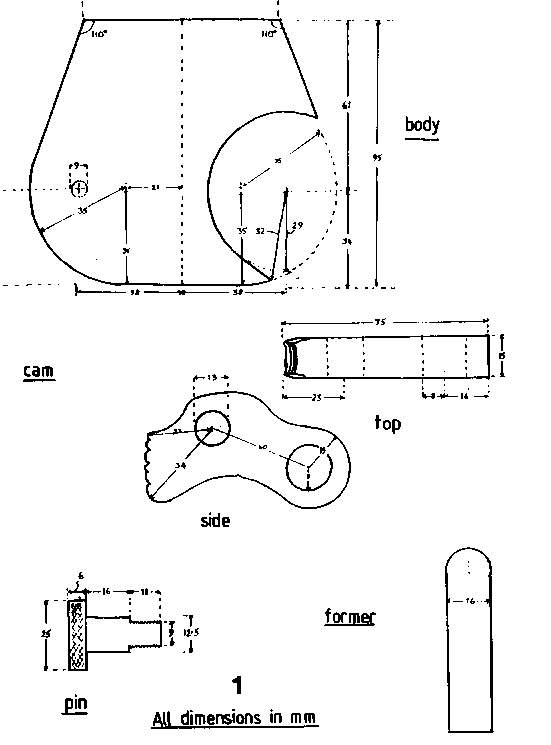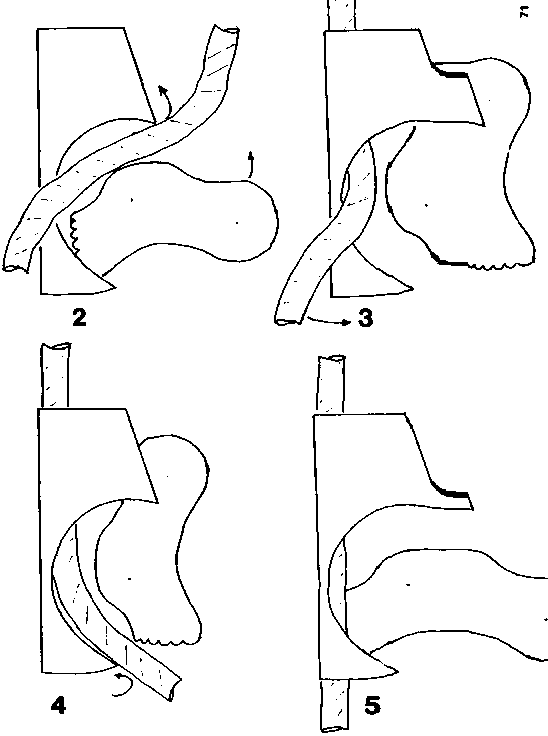A Novel Rope Walking Device: the Warsaw Walker
by Colin Nicholls
As those that have read OUCC Proc. 9 may suspect, there have been interminable
arguments in the club about rope walkers and rope walking versus sit-standers
and Petzl jammers. To summarize for those lucky enough to have missed out
on this prolonged infighting, I have drawn up this table:
| Item |
Pro |
Con |
| Rope walking |
Quicker on big pitches. Less tiring. |
Intricate system required. Slow on short pitch since putting on gear
requires long time. Starting off causes some people problems. |
| Sit-stand |
Simple. Quick on short pitches. Easy to rest. |
Slow on big pitches. Overhangs difficult. |
| Gibbs type ropewalker |
Strong. Grips on muddy and icy rope. |
Needs to be dissembled to put on rope. Bits are separate and can be
lost. |
| Jumar type spring cam jammer |
All one piece. Easy to put on/take off rope. |
Can slip on muddy, etc. rope. Some types subject to spring failure. |
I emphasise that I do not state these to be true, merely that this summarizes
the arguments that I have heard. However I do agree that Gibbs type devices
usually grip better on a muddy rope and for this reason would be preferable,
were it not for the compensating disadvantage that the separate pieces
of a Gibbs need to be chained together.
It was with some interest, therefore, that amongst a pile of mangled
krabs Dave Brooks was showing us in his lecture at the 1980 BCRA conference
in Nottingham I saw a novel rope walker developed at the University of
Warsaw, which had run off a batch of about 500 of them. This particular
one was slightly bent in the testing procedure Dave had put it through,
but other than saying that it was 'surprisingly strong' no comment was
passed on it. I found that rather puzzling since this highly innovative
device was a single piece. There were no strings to snag, bog chains
to break, wires to bend, holes to clog up with mud or parachute pins whose
balls could drop off. Fired by enthusiasm and with mental images of me
shooting up Flat Iron, overtaking the sit-standers and pouring scorn on
the rope walkers who were pouring scorn on the sit-standers, I borrowed
this thing, took it to pieces (the essence of scientific technique is to
take something apart to understand how it works and then why it won't when
you've reassembled it), sketched it and took the drawing back to Oxford.
On getting back to Oxford I showed the blue print (actually a grey print
since they only let me use pencils in here) to an engineering friend of
mine, to ask his advice on constructional details. When he'd got back onto
his chair (I can only assume he had swooned at the excellence of my T.D.
and that he was holding his sides and shaking merely to improve his breathing)
I showed him which way up it should be and which of the grubby doodlings
he was supposed to be considering. We then got down to a discussion of
the how, what and whys.
 Since the device
has effectively only got one side (see figure 1 for overall view) I was
worried about its bursting strength. I therefore wanted to use a thickish
(3/32") piece of stainless for the sheath. Being a practical chap, however,
Phil, pointed out to me that I had to bend it and that I would be better
off using a thick piece of Dural. The advantage of Dural is that it is
less dense than stainless steel and, since the bending moment is proportional
to thickness squared, doubling the thickness would increase the bursting
strength whilst reducing the weight of the sheath. Since the flexural modulus
of Dural is greater than 50% of that of stainless I could make a stronger,
lighter sheath by using thick Dural.
Since the device
has effectively only got one side (see figure 1 for overall view) I was
worried about its bursting strength. I therefore wanted to use a thickish
(3/32") piece of stainless for the sheath. Being a practical chap, however,
Phil, pointed out to me that I had to bend it and that I would be better
off using a thick piece of Dural. The advantage of Dural is that it is
less dense than stainless steel and, since the bending moment is proportional
to thickness squared, doubling the thickness would increase the bursting
strength whilst reducing the weight of the sheath. Since the flexural modulus
of Dural is greater than 50% of that of stainless I could make a stronger,
lighter sheath by using thick Dural.
This I did and then made the cam, again of Dural (it's light, cheap
and there's plenty of chunks of it knocking round our workshop) and bolted
the whole lot together with a 3/8" stainless steel bolt, hammering over
the threads and then covering the lot in Araldite to fix it and smooth
it over at the same time.
With my nice, new, shiny ascenders in my paw I trotted off to test the
things out on one of the trees surrounding Alum Pot. (I chicken out of
a 220' freehanging pitch on untried ascenders. It's an allergy I've called
safety.) The system I used them in was a standard rope walking system -
one Warsaw walker on my ankle, one on my knee and a Lewis ascender on my
shoulder with a Howie belt.
They ran up surprisingly smoothly - I didn't need any weight on the
rope to start off. Then the acid test - how easily would they accidentally
come off the rope? I sat down 15' above the ground with all my weight on
my top (Lewis) ascender (i.e. no weight at all on the Warsaw walkers) and
then I got Martin to vigorously shake the rope. I wasn't sure whether he
thought he was skipping or whipping but the rope flew around for about
a minute and both Warsaw walkers stayed on the rope - success!
How They Work
As you can see
from figure 1 the sheath looks like a Gibbs sheath from which a circle
has been cut out (this in fact could be a way, albeit an expensive one,
for someone with limited facilities to make a Warsaw walker). To put the
device on the rope:
a) pull the krab hole up, lie the upper part of the rope along the cam
and thence hook it inside the sheath (figures 2, 3).
b) pull the krab hole down, lie the lower part of the rope along the
underside of the cam and then hook the rope inside the lower lip
of the sheath (figure 4, 5).
To take the device off the rope the process must be exactly reversed.
In Spain I found these gizmos to be very good indeed. They did wear
a bit so that I had to perform the usual tricks that rope walkers do to
start off on a pitch - maybe a more advanced bearing and more attention
to the top toothed part of the cam would improve this. At no time did these
things come off the rope, except when I took them off - all in all they
performed very well. Some people may wish to make a hole or two in the
sheath to fix elastics for rope walking - that's easy, but you should remember
that if you fix both ends of the elastic to the cam you must fix them both
to the same side of the sheath otherwise you need to undo the elastic when
removing the walker from the rope - defeating the object. Finally a few
points in conclusion, some obvious and some maybe not.
| Pro: |
All one piece - no bits to lose.
Can be put onto rope whilst still attached to you - no dropping them
down pitches.
Work like rope walkers - i.e. on muddy and icy ropes. |
| Con: |
Cannot be used for self lining - I haven't checked the bursting
strength but I guess self lining might be pushing it.
Cannot be used on shoulder - you can't get them off the rope
if your weight is on the rope below the device (I didn't have any problems
on Flat Iron though with the weight of 100m of rope below) - even though
they never come off in use I reckon a Petzl or Gibbs on the shoulder makes
me feel safer (a Petzl made more sense since the whole point is to eliminate
Gibbs).
(Ed's note: as a successful rope walking caver, I'd like to comment
on this point. 1) I can't think how you'd mount a Petzl on your shoulder
so that it would run up the rope easily and hold you close in to the rope.
2) Neither the Petzl nor the Gibbs are as efficient a device for the shoulder
as an ascender containing rollers, e.g. the Lewis (Caves and Caving 13,
p. 26). It's philosophically pleasing to consider a system with three one
piece ascenders but I think that the loss in efficiency due to the Petzl
on the shoulder would outweigh any of the advantages.) |
Note: don't bend your own sheaths unless you either know exactly what you're
doing or, like me, can get the things crack tested.
Contents
 Since the device
has effectively only got one side (see figure 1 for overall view) I was
worried about its bursting strength. I therefore wanted to use a thickish
(3/32") piece of stainless for the sheath. Being a practical chap, however,
Phil, pointed out to me that I had to bend it and that I would be better
off using a thick piece of Dural. The advantage of Dural is that it is
less dense than stainless steel and, since the bending moment is proportional
to thickness squared, doubling the thickness would increase the bursting
strength whilst reducing the weight of the sheath. Since the flexural modulus
of Dural is greater than 50% of that of stainless I could make a stronger,
lighter sheath by using thick Dural.
Since the device
has effectively only got one side (see figure 1 for overall view) I was
worried about its bursting strength. I therefore wanted to use a thickish
(3/32") piece of stainless for the sheath. Being a practical chap, however,
Phil, pointed out to me that I had to bend it and that I would be better
off using a thick piece of Dural. The advantage of Dural is that it is
less dense than stainless steel and, since the bending moment is proportional
to thickness squared, doubling the thickness would increase the bursting
strength whilst reducing the weight of the sheath. Since the flexural modulus
of Dural is greater than 50% of that of stainless I could make a stronger,
lighter sheath by using thick Dural.
